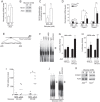Embryonic defence mechanisms against glucose-dependent oxidative stress require enhanced expression of Alx3 to prevent malformations during diabetic pregnancy
- PMID: 28341857
- PMCID: PMC5428206
- DOI: 10.1038/s41598-017-00334-1
Embryonic defence mechanisms against glucose-dependent oxidative stress require enhanced expression of Alx3 to prevent malformations during diabetic pregnancy
Abstract
Oxidative stress constitutes a major cause for increased risk of congenital malformations associated to severe hyperglycaemia during pregnancy. Mutations in the gene encoding the transcription factor ALX3 cause congenital craniofacial and neural tube defects. Since oxidative stress and lack of ALX3 favour excessive embryonic apoptosis, we investigated whether ALX3-deficiency further increases the risk of embryonic damage during gestational hyperglycaemia in mice. We found that congenital malformations associated to ALX3-deficiency are enhanced in diabetic pregnancies. Increased expression of genes encoding oxidative stress-scavenging enzymes in embryos from diabetic mothers was blunted in the absence of ALX3, leading to increased oxidative stress. Levels of ALX3 increased in response to glucose, but ALX3 did not activate oxidative stress defence genes directly. Instead, ALX3 stimulated the transcription of Foxo1, a master regulator of oxidative stress-scavenging genes, by binding to a newly identified binding site located in the Foxo1 promoter. Our data identify ALX3 as an important component of the defence mechanisms against the occurrence of developmental malformations during diabetic gestations, stimulating the expression of oxidative stress-scavenging genes in a glucose-dependent manner via Foxo1 activation. Thus, ALX3 deficiency provides a novel molecular mechanism for developmental defects arising from maternal hyperglycaemia.
Conflict of interest statement
The authors declare that they have no competing interests.
Figures






Similar articles
-
Evidence that elevated glucose causes altered gene expression, apoptosis, and neural tube defects in a mouse model of diabetic pregnancy.Diabetes. 1999 Dec;48(12):2454-62. doi: 10.2337/diabetes.48.12.2454. Diabetes. 1999. PMID: 10580436
-
Oxidant regulation of gene expression and neural tube development: Insights gained from diabetic pregnancy on molecular causes of neural tube defects.Diabetologia. 2003 Apr;46(4):538-45. doi: 10.1007/s00125-003-1063-2. Epub 2003 Mar 26. Diabetologia. 2003. PMID: 12739027
-
[Recent advances in the pathogenesis of diabetic embryopathy].Rev Med Chil. 2009 Dec;137(12):1627-35. Epub 2010 Mar 17. Rev Med Chil. 2009. PMID: 20361141 Review. Spanish.
-
Mechanisms of Congenital Malformations in Pregnancies with Pre-existing Diabetes.Curr Diab Rep. 2020 Sep 12;20(10):54. doi: 10.1007/s11892-020-01338-4. Curr Diab Rep. 2020. PMID: 32918152 Free PMC article. Review.
-
AMP-activated protein kinase mediates effects of oxidative stress on embryo gene expression in a mouse model of diabetic embryopathy.Diabetologia. 2012 Jan;55(1):245-54. doi: 10.1007/s00125-011-2326-y. Epub 2011 Oct 13. Diabetologia. 2012. PMID: 21993711 Free PMC article.
Cited by
-
Impact of mothers' early life exposure to low or high folate on progeny outcome and DNA methylation patterns.Environ Epigenet. 2020 Nov 18;6(1):dvaa018. doi: 10.1093/eep/dvaa018. eCollection 2020. Environ Epigenet. 2020. PMID: 33240529 Free PMC article.
-
Diabetes Causes Dysfunctional Dopamine Neurotransmission Favoring Nigrostriatal Degeneration in Mice.Mov Disord. 2020 Sep;35(9):1636-1648. doi: 10.1002/mds.28124. Epub 2020 Jul 15. Mov Disord. 2020. PMID: 32666590 Free PMC article.
-
Zebrafish models of alx-linked frontonasal dysplasia reveal a role for Alx1 and Alx3 in the anterior segment and vasculature of the developing eye.Biol Open. 2022 May 15;11(5):bio059189. doi: 10.1242/bio.059189. Epub 2022 Jun 7. Biol Open. 2022. PMID: 35142342 Free PMC article.
-
Association Analysis Between SNPs in the Promoter Region of RGS4 and Schizophrenia in the Northern Chinese Han Population.Neuropsychiatr Dis Treat. 2020 Apr 16;16:985-992. doi: 10.2147/NDT.S250282. eCollection 2020. Neuropsychiatr Dis Treat. 2020. PMID: 32346293 Free PMC article.
-
Navigating redox imbalance: the role of oxidative stress in embryonic development and long-term health outcomes.Front Cell Dev Biol. 2025 Mar 26;13:1521336. doi: 10.3389/fcell.2025.1521336. eCollection 2025. Front Cell Dev Biol. 2025. PMID: 40206404 Free PMC article. Review.
References
Publication types
MeSH terms
Substances
LinkOut - more resources
Full Text Sources
Other Literature Sources
Medical
Molecular Biology Databases
Research Materials
Miscellaneous

